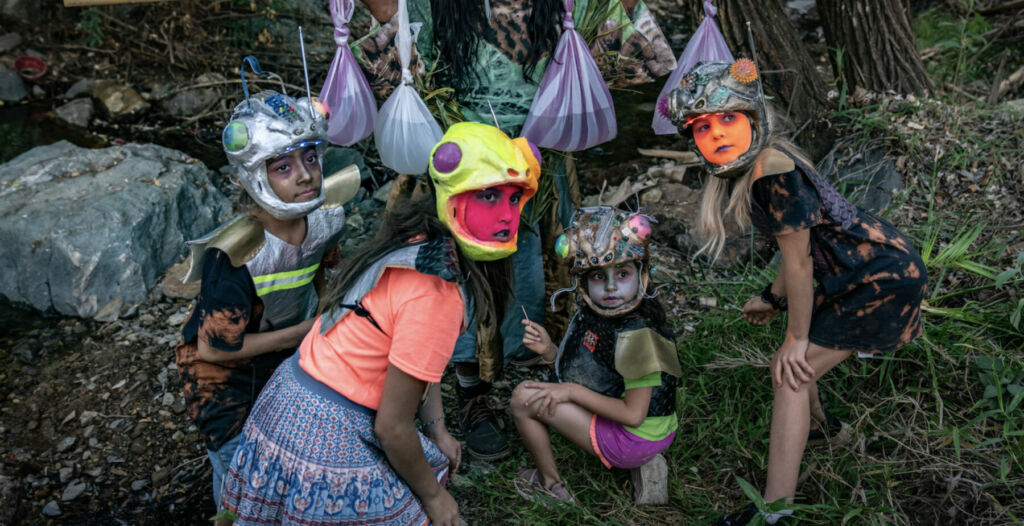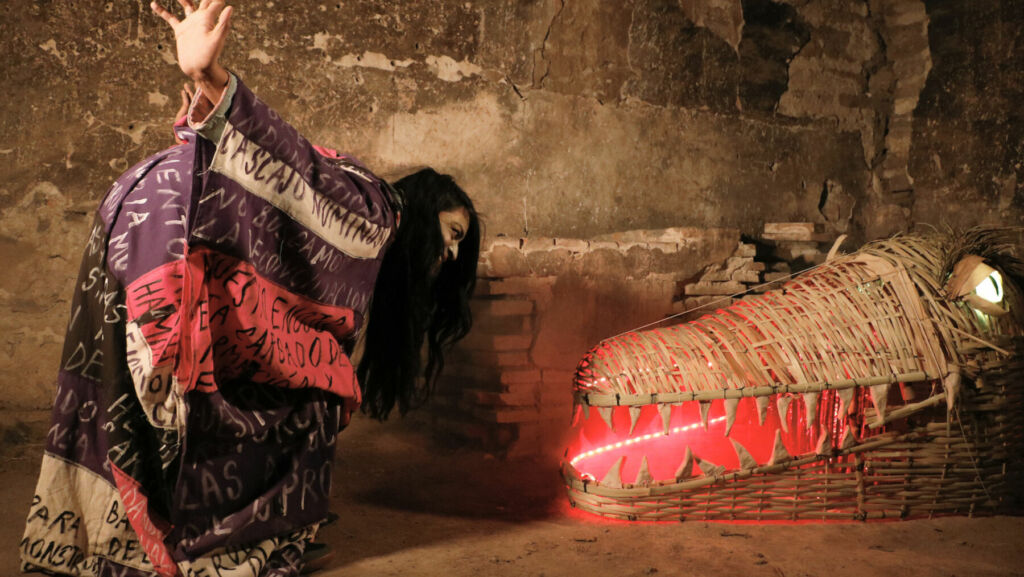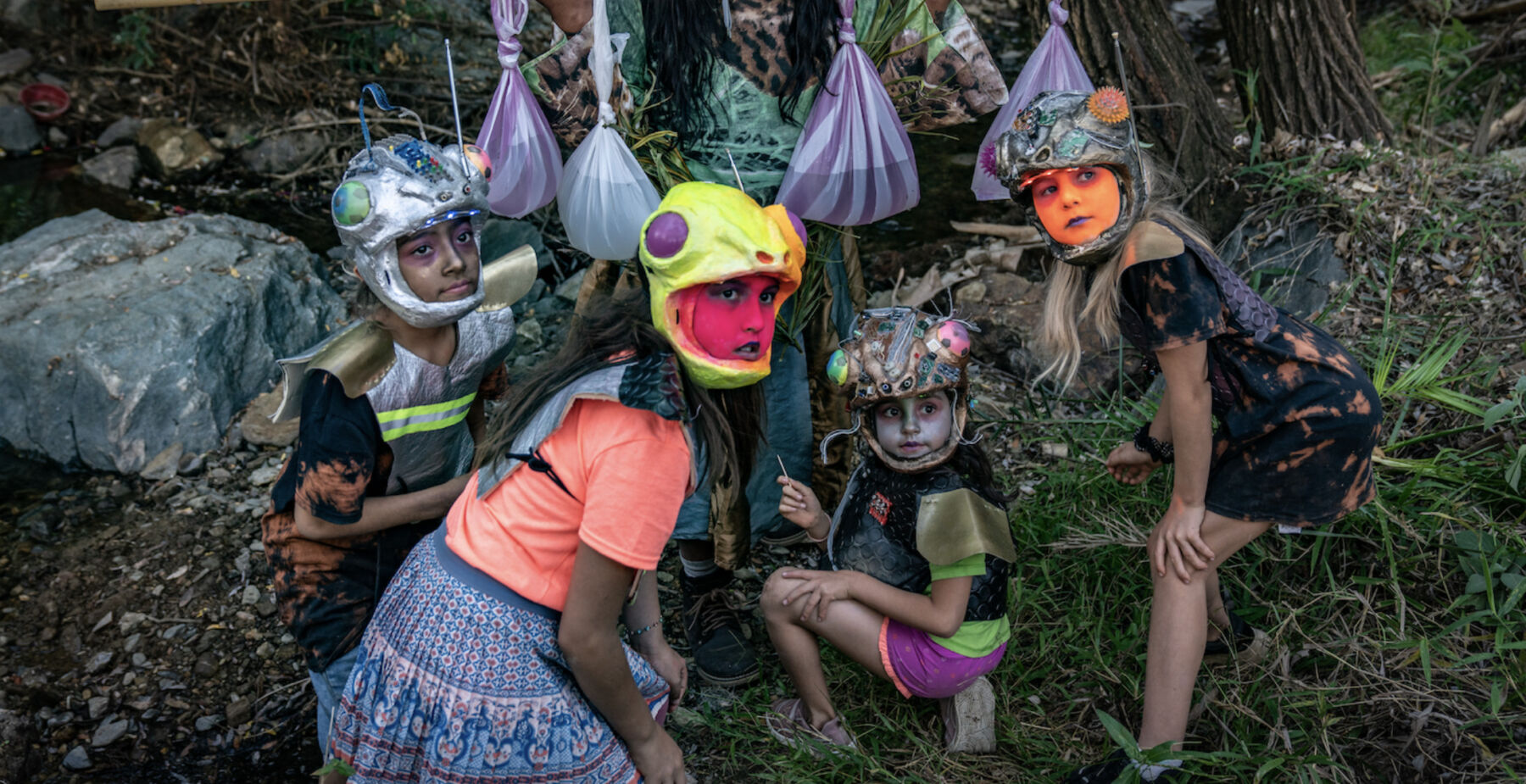Interview by Agata Kik

The practice of queer and of colour feminist artist Naomi Rincón Gallardo deals with interspecies existences that are “exposed to heteropatriarchal forces of dispossession and destruction”. Guided by pleasure and desire, despite the macabresque Mesoamerican imagery, through their multidisciplinary works, the artist advocates joy, readiness to care and togetherness, to disobey in this way the prevailing normativity, heteropatriarchy, and the symbolic orders of coloniality, as a way out of the stiffening necropolitics of the present day.
Despite their situatedness within damaged dystopian worlds, the artworks’ environments and multispecies’ entanglements act as a preparation for a celebration and express the artist’s fight for liveable and pleasurable worlds.
In the spirit of the struggle of Zapotec environmental activist Rosalinda Dionisio Sánchez, for her solo show ‘Resiliencia Tlacuache’ (‘Opossum Resilience’) at Parallel Oaxaca in 2019, Gallardo produced a multimedia installation exploring Mesoamerican myths, questioning the ideas of time and territory, proposing restorative narratives to reclaim harmony between people and their natural resources. Following, in 2020 the artist’s participation in the 11th Biennial of Contemporary Art of Berlin developed into work that further criticised the mining industry of the State of Oaxaca to bring attention to the traditional communities and their ancestral belief systems.
On show at Rewire festival 2023 edition, as part of Proximity Music: Visceral Acts exhibition, Gallardo present their new performative project – ‘Vermin’s Radio’ that will expand on the artist’s already existing video ‘Sonnet of Vermin’, also shown part of an earlier exhibition representing Mexico at La Biennale di Venezia in 2022. The film itself is a surreal story of chimerical creatures that occupy the in-between spaces of the species found in Mesoamerican underworlds that celebrate the disastrously degraded natural worlds.
The work is one of the artist’s “narratives that refuse a grammar of violence while acknowledging its existence”. Crossed by rivers flowing with drug-resistant bacteria, the dystopian scenario presents cheerful cyborgian organisms, who have learnt how to metabolise the toxins or get nourished with polyethylene. Bats, scorpions, frogs, snakes and lizards inhabit and make themselves comfortable within the systemic cracks, reclaiming ruin as their new home.
The eccentric beings and their fragmented physicalities in Gallardo’s works, not only ‘stay with the trouble’, but glorify their liminal lives, thriving at the thresholds of death, having a great time, but most importantly, never being left alone. The themes of ‘collective rituality’ and ‘collective belonging’ are prominent and characteristic in Gallardo’s practice. During Rewire festival, the audience members also have a chance to try on some wearable props that make sounds, to immerse themselves in the artist’s imaginary ‘counter-worlds’, a way of life in itself in our common present and the future on the devastated planet.
The art of activism within Rincon’s practice can be seen as “daily practice and a process of becoming” that belongs to the artfulness of the everyday beyond craftsmanship and formal skills. The orientation of opposition is never still and so for the artist to deal with political and social issues, it demands absolute alertness and adaptability to the ever-changing circumstances of injustice, precariousness and unpredictability. According to Naomi Rincón Gallardo: ‘prioritizing relational worlds has become a matter of life or death’.

For those who are not familiar with your work, could you please briefly describe your current artistic practice?
I describe my worldmaking as mythical/political fabulations that tell stories of entangled creatures (human and more than human) who resist, seek pleasure, re-exist and resurrect within a neocolonial necropolis. I write the scripts and lyrics for my videos and collaborate with performers, musicians, sound artists, cinematographers, seamstresses, and craftsmen. I build exuberant, crafty and low-cost elaborated paraphernalia and attires that embrace degraded aesthetics while involving no mastery but inventive capacities and affective manual labour. I can define my multi-disciplinary work as queer/feminist political handmade surrealism.
You create performances, films, and video installations that interweave Mesoamerican cosmologies, queer theory, critical pedagogy, and Latin American decolonial feminism in political ways; how do they intersect with one another in your work? And how their respective weight in your practice has evolved throughout the years?
My work aims to interanimate epistemological crossings between inheritances of women of colour feminisms, queer of colour scholarship and decolonial feminism in mutually enhancing ways. I find the intersection among them in the desire to dismantle hierarchical symbolic orders of coloniality and in the aspiration to recover the pulse of life in its multiplicity, ambiguity and unpredictability. As a queer of colour feminist from the global south, I try to keep my antennas tuned to the realities of those -human and non-human- that are constantly exposed to heteropatriarchal forces of dispossession and destruction. Yearning for decolonial presents and futures is not a fixed stance that one reaches once and for all. It is rather a crafty daily practice and a process of becoming that demands keeping oneself alert to the different axis of oppression and power relations in order to rearticulate and update an oppositional consciousness under ever-changing circumstances and contexts.
In your video performances/work, you combine speculative fiction, theatre games, different popular music styles, and D.I.Y. costumes to build what you define as “counter worlds;” could you please elaborate more on this? What do “counter-wolds” mean to you?
Counter-worlds is a way to call an oppositional imagination that disobeys normativity, heteropatriarchy, and the symbolic orders of coloniality. The plots of these counter-worlds are fueled by indignation in tension with hope and desire. In spite of the necropolitical forces of terror that are rapidly spreading over territories that have been colonized -such as the Mexican territory, where I’m based-, my counter-worlds insist on claiming livable and pleasurable worlds. The demand is not just to survive but to play loud!
For your practice, you mention that you try to articulate an embodied theory intertwined with nature and matter: a theory that can be danced, smelled, and touched. How do you approach the distribution of attention between the different senses?
I like to think of my practice as a preparation for a celebration, a collective rituality that invokes chaotic powers that re-invigorate life. There is an invitation to create -sometimes ephemeral, sometimes long-lasting- forms of collective belonging. It requires detailed preparations, hospitality and the promise of joy. A worldmaking that centres joy, pleasure and touch (whether physical or emotional), practices a politics that is accountable for conditions of livability that take intimacy seriously.
Perhaps this entanglement of different senses blossoms from forms of sociality and collaboration that are well known in our colonized societies: the joy of waste despite precariousness, the tenacity to endure under harsh circumstances, the wonderment at contingent forms of creative belonging. In spite of brutal forms of violence and dispossession, the option to prioritize affective relations and corporality over profit and individualism is still feasible. Or perhaps it is even more than that: prioritizing relational worlds has become a matter of life or death.
For this year’s edition of Rewire festival, you will present the musical film Sonnet of Vermin, a manifesto for unwanted species. Conveying queer, transgressive and subversive messages, the film creates a counter-world in which marginalized vermin and humans learn to co-evolve in a toxic landscape in Mesoamerica. What are the challenges of such a video performance?
Sonnet of Vermin is part of a yet unfinished trilogy that attempts to find ways to acknowledge the proximity to death as a condition that constitutes life in a territory that has become a colonial necropolis. For over fifteen years now, the Mexican territory has gone through a painful period of unleashed violence and naturalized danger involving the multiplication of disappearances and killings, a reloaded wave of extractivism and dispossession, the multiplication of paramilitary and criminal groups accompanied by the militarization of the country. The challenge of this series of works is to create narratives that refuse a grammar of violence while acknowledging its existence. Instead, the works attempt to create a fabulation guided by desire.
In what ways, do you think using vermin not only humans, aids to drive the narrative of the film?
I often invite non-human creatures to my worldmaking. Sometimes they are part animal, part human, or monstrous: assemblages of entangled embodiments resisting and exceeding modern/colonial gender systems of classification. I thought of vermin as a bunch of unwanted creatures that attempt to syntonizer each other through radio antennas in the search of a sort of subaltern solidarity. I wanted also to relate this narrative with contemporary exclusionary arrangements that render entire populations disposable or superfluous. The premise is simple, these creatures may be unwanted, but they are desiring ones, and they also have the capacity to entangle, connect and organize with others across their differences.
What does Sonnet of Vermin entail, and how was your physical and emotional state during its development?
Sonnet of Vermin imagines a bunch of creatures that are rendered as killable in a moment of planetary cataclysm. The characters are: a bat who is a radio broadcaster from a tomb, a group of frog-cyborg children who have learned how to metabolize toxins of a polluted river, a queer scorpion who claims the right to infect, a snake who changes her skin announcing the change of cycle, a voracious alligator and a radio-faced funerary bundle (in precolonial times, there was a Mesoamerican funerary practice consisting in the creation of sacred bundles where dead bodies would be wrapped together with ritualistic objects).
These characters seek ways to be entangled through antennas, and they also connect with the voices of the dead that the radio broadcasts from the tomb. I guess that the work is a call for relationality and solidarity across differences in the midst of social, political and ecological devastation. It is also a call to take care of the dead in a context ruled by necropolitics. My physical and emotional state? Well, it varied a lot, from indignation to excitement, from despair to lots of fun, from frustration to bliss. As it usually happens in a creative process!
Could you tell us a bit about the residency developed for Rewire Festival 2023?
In the Residency at iii I am turning some props and masks of the videos into noise devices. Some of the hand-made props of the video had some electronic garbage pasted on top, but they did not have any function besides the look… But with the great support and massive patience of Erfan Abdi and Kacper Ziemianin, the masks now actually have started to make weird sounds, that go pretty well with all the aesthetics and spirit of the video. It is exciting because even though I imagined them that way when I made the work, I did not have any idea of how to make that actually happen, and now it’s becoming real.
Solitude or loneliness, how do you spend your time alone?
To my understanding in Spanish -my mother tongue- there is no different word for solitude or loneliness; we would use “soledad” for both. However, as far as I understand loneliness comprises some affective mode related to being disconnected from others. In that case, I would say that solitude would be a better word for the time I am alone. I spend most of the time in the research process, script writing, prop-making and editing on my own, working in my garden/studio. But in the preparations for the shooting and recordings, there are plenty of people involved and that’s when the feeling of blissful or sometimes conflictive relationality happens. That’s the magic of it.






